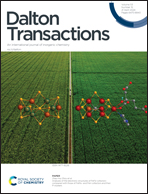Ba3SnGa10−xInxO20 (0 ≤ x ≤ 2): site-selective doping, band structure engineering and photocatalytic overall water splitting†
Abstract
Developing new photocatalysts and deciphering the structure–property relationship are always the central topics in photocatalysis. In this study, a new photocatalyst Ba3SnGa10O20 containing two d10 metal cations was prepared by a high temperature solid state reaction, and its crystal structure was investigated by Rietveld refinements of monochromatic X-ray powder diffraction data for the first time. There are 2 Ba, 4 metal cations and 6 O independent atoms in a unit cell. Sn4+ and Ga3+ co-occupy the octahedral cavities named M1 and M2 sites, and the other two metal sites are fully occupied by Ga3+. Rational In3+-to-Ga3+ substitution was performed to reduce the potential of the conduction band minimum and enhance the light absorption ability, which was indeed confirmed using UV-vis diffuse reflectance spectra and Mott–Schottky plots for Ba3SnGa10−xInxO20 (0 ≤ x ≤ 2). Interestingly, In3+ exhibits site selective doping at M1 and M2 sites exclusively. With the light absorption ability enhanced, the photocatalytic overall water splitting activity was also improved, i.e. the photocatalytic H2 generation rate was 1.7(1) μmol h−1 for Ba3SnGa10O20, and the optimal catalyst Ba3SnGa8.5In1.5O20 loaded with 1.0 wt% Pd exhibited the H2 generation rate of 27.5(4) μmol h−1 and the apparent quantum yield at 254 nm was estimated to be 2.28% in pure water.



 Please wait while we load your content...
Please wait while we load your content...